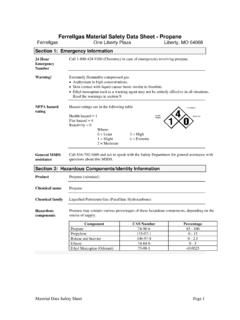Transcription of Signs and Symptoms of Approaching Death
1 Signs and Symptoms of Approaching Death Dynamics of the Dying Process Physical Signs When a person enters the final stage of the dying process, two different dynamics are at work which are closely interrelated and interdependent. On the physical plane, the body begins the final process of shutting down, which will end when all the physical systems cease to function. Usually this is an orderly and undramatic progressive series of physical changes which are not medical emergencies requiring invasive interventions. These physical changes are a normal, natural way in which the body prepares itself to stop, and the most appropriate kinds of responses are comfort enhancing measures. Emotional-Spiritual Signs The other dynamic of the dying process at work is on the emotional-spiritual plane, and is a different kind of process.
2 The spirit of the dying person begins the final process of release from the body, its immediate environment, and all attachments. This release also tends to follow its own priorities, which may include the resolution of whatever is unfinished of a practical nature and reception of permission to let go' from family members. These events are the normal, natural way in which the spirit prepares to move from this existence into the next dimension of life. The most appropriate kinds of responses to the emotional-spiritual changes are those which support and encourage this release. The experience we call Death occurs when the body completes its natural process of shutting down, and when the spirit completes its natural process of reconciling and finishing. These two processes need to happen in a way appropriate and unique to the values, beliefs, and lifestyle of the dying person.
3 How Palliative Care Helps Therefore, as you seek to prepare yourself as this event approaches, the members of your Palliative Care team want you to know what to expect and how to respond in ways that will help your loved one accomplish this final stage with support, understanding and ease. This is the great gift of love you have to offer your loved one as this moment approaches. The emotional-spiritual and physical Signs and Symptoms of impending Death which follow are offered to help you understand the natural kinds of things which may happen and how you can respond appropriately. Not all these Signs and Symptoms will occur with every person, nor will they occur in this particular sequence. Each person is unique and needs to do things in his or her own way. This is not the time to try to change your loved one, but the time to give full acceptance, support and comfort.
4 Signs and Symptoms of how the body prepares itself for the final stage of life Coolness The person's hands and arms, feet and then legs may be increasingly cool to the touch, and at the same time the colour of the skin may change. This is a normal indication that the circulation of blood is decreasing to the body's extremities and being reserved for the most vital organs. Keep the person warm with a blanket, but do not use one that is electric. Sleeping The person may spend an increasing amount of time sleeping, and appear to be uncommunicative or unresponsive and at times be difficult to arouse. This normal change is due in part to changes in the metabolism of the body. Sit with your loved one, hold his or her hand, but do not shake it or speak loudly. Speak softly and naturally. Plan to spend time with your loved one during those times when he or she seems most alert or awake.
5 Do not talk about the person in the person's presence. Speak to him or her directly as you normally would, even though there may be no response. Never assume the person cannot hear, hearing is the last of the senses to be lost. Disorientation The person may seem to be confused about the time, place and identity of the people surrounding him or her including close and familiar people. This is also due in part to the metabolism changes. Identify yourself by name before you speak rather than ask the person to guess who you are. Speak softly, clearly and truthfully when you need to communicate something important for the patient's comfort, such as, it is time to take your medication. Explain the reason for the communication, such as, so you won't feel the pain. Do not use this method to try to manipulate the patient to meet your needs.
6 Incontinence The person may lose control of urine and/or bowel matter as the muscles in that area begin to relax. Discuss with your Palliative Care nurse what can be done to protect the bed and keep your loved one clean and comfortable. Secretions The person may have gurgling sounds coming from his or her chest. These sounds may become very loud. This normal change is due to the decrease of fluid intake and an inability to cough up normal secretions. Suctioning usually only increases the secretions and causes sharp discomfort. Gently turn the person's head to the side and allow gravity to drain the secretions. You may also wipe the mouth gently with a moist cloth. The sound does not indicate the onset of severe or new pain. Medication is available to help with this stage if desired. Restlessness The person may make restless and repetitive motions such as pulling at bed linen or clothing.
7 This often happens and is due in part to the decrease in oxygen circulation to the brain and to metabolism changes. Do not interfere with or try to restrain such motions. To have a calming effect, speak in a quiet natural way. Medication is available to help with this stage if required. Your Palliative Care team members will assist you in identifying what may be happening, and help you find ways to help the person find release from the tension or fear. Other things which may be helpful in calming the person are to recall a favourite place the person enjoyed, a favourite experience, read something comforting, play music or lightly massage the forehead and give assurance that it is okay to let go. Reduced Production of Urine The person's urine output normally decreases and may become tea coloured often referred to as concentrated urine.
8 This is due to the decreased fluid intake as well as decrease in circulation through the kidneys. Consult with your Palliative Care nurse to determine whether there may be a need to irrigate or insert a catheter. Reduced intake of Fluid and Food The person may have a decrease in appetite and thirst, wanting little or no food or fluid. The body will naturally begin to conserve energy which is expended on these tasks. Do not try to force food or drink into the person, or try to use guilt to manipulate them into eating or drinking something. To do this only makes the person much more uncomfortable. Small chips of ice, frozen Gatorade or juice may be refreshing in the mouth. If the person is able to swallow, fluids may be given in small amounts by a syringe (ask the nurse for guidance). Cleaning the mouth with sodium bicarbonate mouthwash and/or swabs and using lip conditioners is also comforting.
9 A cool, moist washcloth on the forehead may also increase physical comfort. Breathing Pattern Change The person's regular breathing pattern may change with the onset of a different breathing pace. A. particular pattern consists of breathing irregularly, ie shallow breaths with periods of no breathing of 5 to 30 seconds and up to a full minute. This is called Cheyne-Stokes breathing. The person may also experience periods of rapid shallow pant-like breathing. These patterns are very common and indicate decrease in circulation in the internal organs. Elevating the head, and/or turning the person onto his or her side may bring comfort. Hold your loved one's hand. Speak gently. Normal Emotional, Spiritual and Mental Signs and Symptoms with Appropriate Responses Withdrawal The person may seem unresponsive, withdrawn, or in a comatose-like state.
10 This indicates preparation for release, a detaching from surroundings and relationships, and a beginning of letting go. Since hearing remains all the way to the end, speak to your loved one in your normal tone of voice, identifying yourself by name when you speak, hold his or her hand and say whatever you need to say that will help the person let go. Vision-Like Experiences The person may speak or claim to have spoken to persons who have already died, or to see or have seen places not presently accessible or visible to you. This does not indicate an hallucination or a drug reaction. The person is beginning to detach from this life and is being prepared for their Death , so it will not be so frightening. Do not contradict, explain it away, belittle or argue about what the person claims to have seen or heard.





